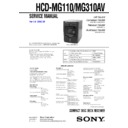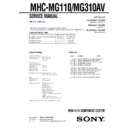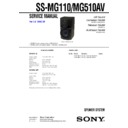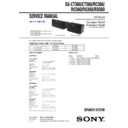Sony HCD-MG110 / HCD-MG310AV / MHC-MG110 / MHC-MG310AV Service Manual ▷ View online
2
HCD-MG110/MG310AV
TABLE OF CONTENTS
FM tuner section
Tuning range
87.5 – 108.0 MHz
Antenna
FM lead antenna
Antenna terminals
North American model:
North American model:
75 ohms unbalanced
Australian model:
75 ohms balanced
Intermediate frequency
10.7 MHz
AM tuner section
Tuning range
US, Canadian and Mexican model:
US, Canadian and Mexican model:
530 – 1,710 kHz
(with the interval set at
10 kHz)
531 – 1,710 kHz
(with the interval set at
9 kHz)
(with the interval set at
10 kHz)
531 – 1,710 kHz
(with the interval set at
9 kHz)
Australian model:
531 – 1,602 kHz
(with the interval set at
9 kHz)
(with the interval set at
9 kHz)
Antenna
AM loop antenna
Antenna terminals
External antenna terminal
Intermediate frequency
450 kHz
General
Power requirements
US, Canadian and Mexican model:
US, Canadian and Mexican model:
120 V AC, 60 Hz
Australian model:
220 – 240 V AC,
50/60 Hz
50/60 Hz
Power consumption
US, Canadian and Mexican model
MHC-MG310AV:
US, Canadian and Mexican model
MHC-MG310AV:
200 watts
MHC-MG110:
150 watts
Australian model
MHC-MG310AV:
MHC-MG310AV:
200 watts
Dimensions (w/h/d) incl. projecting parts and controls
Approx. 280
×
383
×
480
mm
Mass
MHC-MG310AV:
MHC-MG310AV:
Approx. 11.3 kg
MHC-MG110:
Approx. 10.9 kg
Supplied accessories:
Remote commander (1)
Batteries (2)
AM loop antenna (1)
FM lead antenna (1)
Rear speaker cords
(MG310AV only) (2)
Center speaker pads
(attached to the backside
of the center speaker)
(MG310AV only) (2)
Video cable (Australian
model only) (1)
Batteries (2)
AM loop antenna (1)
FM lead antenna (1)
Rear speaker cords
(MG310AV only) (2)
Center speaker pads
(attached to the backside
of the center speaker)
(MG310AV only) (2)
Video cable (Australian
model only) (1)
Design and specifications are subject to change
without notice.
without notice.
1.
SERVICING NOTE
..................................................
4
2.
GENERAL
...................................................................
5
3.
DISASSEMBLY
3-1. Disassembly Flow ...........................................................
7
3-2. Upper Cover ....................................................................
8
3-3. Front Block Assy .............................................................
8
3-4. MAIN Board ...................................................................
9
3-5. Back Panel, DC Fan (M391) (Australian model) ...........
9
3-6. MAIN AMP Board, POWER Board ............................... 10
3-7. Middle (F) Assy, Bracket (Middle-R),
3-7. Middle (F) Assy, Bracket (Middle-R),
Power Bracket ................................................................. 10
3-8. Mechanism Deck (CDM64-K1BD44A) ......................... 11
3-9. Base Unit (BU-K1BD44A) ............................................. 11
3-10. BU Holder Assy .............................................................. 12
3-11. Motor Gear Assy (Sled) (M102), CD Board .................. 12
3-12. Op Base Assy (KSM-213BFN) ...................................... 13
3-13. Cassette Lid Assy (A)/(B) ............................................... 13
3-14. Mech Deck (TAPE) ......................................................... 14
3-9. Base Unit (BU-K1BD44A) ............................................. 11
3-10. BU Holder Assy .............................................................. 12
3-11. Motor Gear Assy (Sled) (M102), CD Board .................. 12
3-12. Op Base Assy (KSM-213BFN) ...................................... 13
3-13. Cassette Lid Assy (A)/(B) ............................................... 13
3-14. Mech Deck (TAPE) ......................................................... 14
4.
TEST MODE
.............................................................. 15
5.
MECHANICAL ADJUSTMENTS
....................... 16
6.
ELECTRICAL ADJUSTMENTS
Deck Section ............................................................................. 16
CD Section ................................................................................ 18
CD Section ................................................................................ 18
7.
DIAGRAMS
7-1. Block Diagram – CD SERVO Section – ........................ 21
7-2. Block Diagram – TUNER/TAPE DECK Section – ...... 22
7-3. Block Diagram – SURROUND Section – ...................... 23
7-4. Block Diagram – AMP Section – ................................... 24
7-5. Block Diagram
7-2. Block Diagram – TUNER/TAPE DECK Section – ...... 22
7-3. Block Diagram – SURROUND Section – ...................... 23
7-4. Block Diagram – AMP Section – ................................... 24
7-5. Block Diagram
– DISPLAY/POWER SUPPLY Section – ...................... 25
7-6. Note for Printed Wiring Boards and
Schematic Diagrams ....................................................... 26
7-7. Schematic Diagram – CD Section – ............................... 28
7-8. Printed Wiring Board – CD Section – ............................ 29
7-9. Printed Wiring Boards
7-8. Printed Wiring Board – CD Section – ............................ 29
7-9. Printed Wiring Boards
– CD MOTOR/SENSOR Section – ................................ 30
7-10. Schematic Diagram
– CD MOTOR/SENSOR Section – ................................ 31
7-11. Printed Wiring Board – TC Section – ............................. 32
7-12. Schematic Diagram – TC Section – ............................... 33
7-13. Schematic Diagram – MAIN Section (1/4) – ................. 34
7-14. Schematic Diagram – MAIN Section (2/4) – ................. 35
7-15. Schematic Diagram – MAIN Section (3/4) – ................. 36
7-16. Schematic Diagram – MAIN Section (4/4) – ................. 37
7-17. Printed Wiring Board – MAIN Section – ....................... 38
7-18. Printed Wiring Boards – AMP Section – ........................ 40
7-19. Schematic Diagram – AMP Section – ............................ 41
7-20. Printed Wiring Boards – DISPLAY Section – ............... 42
7-21. Schematic Diagram – DISPLAY Section – .................... 43
7-22. Printed Wiring Board – CONTROL Section – ............... 44
7-23. Schematic Diagram – CONTROL Section – .................. 45
7-24. Printed Wiring Boards – POWER Section – .................. 46
7-25. Schematic Diagram – POWER Section – ...................... 47
7-26. IC Pin Function Description ........................................... 48
7-12. Schematic Diagram – TC Section – ............................... 33
7-13. Schematic Diagram – MAIN Section (1/4) – ................. 34
7-14. Schematic Diagram – MAIN Section (2/4) – ................. 35
7-15. Schematic Diagram – MAIN Section (3/4) – ................. 36
7-16. Schematic Diagram – MAIN Section (4/4) – ................. 37
7-17. Printed Wiring Board – MAIN Section – ....................... 38
7-18. Printed Wiring Boards – AMP Section – ........................ 40
7-19. Schematic Diagram – AMP Section – ............................ 41
7-20. Printed Wiring Boards – DISPLAY Section – ............... 42
7-21. Schematic Diagram – DISPLAY Section – .................... 43
7-22. Printed Wiring Board – CONTROL Section – ............... 44
7-23. Schematic Diagram – CONTROL Section – .................. 45
7-24. Printed Wiring Boards – POWER Section – .................. 46
7-25. Schematic Diagram – POWER Section – ...................... 47
7-26. IC Pin Function Description ........................................... 48
8.
EXPLODED VIEWS
8-1. General Section ............................................................... 54
8-2. Front Panel Section ......................................................... 55
8-3. Chassis Section ............................................................... 56
8-4. Mechanism Deck Section (CDM64-K1BD44A) ........... 57
8-5. Base Unit Section (BU-K1BD44A) ............................... 58
8-2. Front Panel Section ......................................................... 55
8-3. Chassis Section ............................................................... 56
8-4. Mechanism Deck Section (CDM64-K1BD44A) ........... 57
8-5. Base Unit Section (BU-K1BD44A) ............................... 58
9.
ELECTRICAL PARTS LIST
............................... 59
Ver 1.3
3
HCD-MG110/MG310AV
Fig. A.
Using an AC voltmeter to check AC leakage.
1.5 k
Ω
0.15
µ
F
AC
voltmeter
(0.75 V)
voltmeter
(0.75 V)
To Exposed Metal
Parts on Set
Parts on Set
Earth Ground
SAFETY CHECK-OUT
After correcting the original service problem, perform the follow-
ing safety check before releasing the set to the customer:
Check the antenna terminals, metal trim, “metallized” knobs,
screws, and all other exposed metal parts for AC leakage.
Check leakage as described below.
ing safety check before releasing the set to the customer:
Check the antenna terminals, metal trim, “metallized” knobs,
screws, and all other exposed metal parts for AC leakage.
Check leakage as described below.
LEAKAGE TEST
The AC leakage from any exposed metal part to earth ground and
from all exposed metal parts to any exposed metal part having a
return to chassis, must not exceed 0.5 mA (500 microamperes.).
Leakage current can be measured by any one of three methods.
1. A commercial leakage tester, such as the Simpson 229 or RCA
from all exposed metal parts to any exposed metal part having a
return to chassis, must not exceed 0.5 mA (500 microamperes.).
Leakage current can be measured by any one of three methods.
1. A commercial leakage tester, such as the Simpson 229 or RCA
WT-540A. Follow the manufacturers’ instructions to use these
instruments.
instruments.
2. A battery-operated AC milliammeter. The Data Precision 245
digital multimeter is suitable for this job.
3. Measuring the voltage drop across a resistor by means of a
VOM or battery-operated AC voltmeter. The “limit” indica-
tion is 0.75 V, so analog meters must have an accurate low-
voltage scale. The Simpson 250 and Sanwa SH-63Trd are ex-
amples of a passive VOM that is suitable. Nearly all battery
operated digital multimeters that have a 2 V AC range are
suitable. (See Fig. A)
tion is 0.75 V, so analog meters must have an accurate low-
voltage scale. The Simpson 250 and Sanwa SH-63Trd are ex-
amples of a passive VOM that is suitable. Nearly all battery
operated digital multimeters that have a 2 V AC range are
suitable. (See Fig. A)
CAUTION
Use of controls or adjustments or performance of procedures
other than those specified herein may result in hazardous ra-
diation exposure.
other than those specified herein may result in hazardous ra-
diation exposure.
This appliance is classified as a CLASS 1 LASER product.
The CLASS 1 LASER PRODUCT MARKING is located on
the rear exterior.
The CLASS 1 LASER PRODUCT MARKING is located on
the rear exterior.
Laser component in this product is capable of emitting radiation
exceeding the limit for Class 1.
exceeding the limit for Class 1.
SAFETY-RELATED COMPONENT WARNING!!
COMPONENTS IDENTIFIED BY MARK
0
OR DOTTED
LINE WITH MARK
0
ON THE SCHEMATIC DIAGRAMS
AND IN THE PARTS LIST ARE CRITICAL TO SAFE
OPERATION. REPLACE THESE COMPONENTS WITH
SONY PARTS WHOSE PART NUMBERS APPEAR AS
SHOWN IN THIS MANUAL OR IN SUPPLEMENTS PUB-
LISHED BY SONY.
OPERATION. REPLACE THESE COMPONENTS WITH
SONY PARTS WHOSE PART NUMBERS APPEAR AS
SHOWN IN THIS MANUAL OR IN SUPPLEMENTS PUB-
LISHED BY SONY.
The laser diode in the optical pick-up block may suffer electro-
static break-down because of the potential difference generated
by the charged electrostatic load, etc. on clothing and the human
body.
During repair, pay attention to electrostatic break-down and also
use the procedure in the printed matter which is included in the
repair parts.
The flexible board is easily damaged and should be handled with
care.
static break-down because of the potential difference generated
by the charged electrostatic load, etc. on clothing and the human
body.
During repair, pay attention to electrostatic break-down and also
use the procedure in the printed matter which is included in the
repair parts.
The flexible board is easily damaged and should be handled with
care.
NOTES ON LASER DIODE EMISSION CHECK
The laser beam on this model is concentrated so as to be focused
on the disc reflective surface by the objective lens in the optical
pick-up block. Therefore, when checking the laser diode emis-
sion, observe from more than 30 cm away from the objective lens.
on the disc reflective surface by the objective lens in the optical
pick-up block. Therefore, when checking the laser diode emis-
sion, observe from more than 30 cm away from the objective lens.
LASER DIODE AND FOCUS SEARCH OPERATION
CHECK
CHECK
Carry out the “S curve check” in “CD section adjustment” and
check that the S curve waveforms is output three times.
check that the S curve waveforms is output three times.
NOTES ON HANDLING THE OPTICAL PICK-UP
BLOCK OR BASE UNIT
BLOCK OR BASE UNIT
Notes on chip component replacement
• Never reuse a disconnected chip component.
• Notice that the minus side of a tantalum capacitor may be dam-
• Notice that the minus side of a tantalum capacitor may be dam-
aged by heat.
Flexible Circuit Board Repairing
• Keep the temperature of the soldering iron around 270 ˚C dur-
ing repairing.
• Do not touch the soldering iron on the same conductor of the
circuit board (within 3 times).
• Be careful not to apply force on the conductor when soldering
or unsoldering.
Ver 1.1
ATTENTION AU COMPOSANT AYANT RAPPORT
À LA SÉCURITÉ!
LES COMPOSANTS IDENTIFIÉS PAR UNE MARQUE
0
SUR LES DIAGRAMMES SCHÉMATIQUES ET LA LISTE
DES PIÈCES SONT CRITIQUES POUR LA SÉCURITÉ
DE FONCTIONNEMENT. NE REMPLACER CES COM-
POSANTS QUE PAR DES PIÈCES SONY DONT LES
NUMÉROS SONT DONNÉS DANS CE MANUEL OU
DANS LES SUPPLÉMENTS PUBLIÉS PAR SONY.
DES PIÈCES SONT CRITIQUES POUR LA SÉCURITÉ
DE FONCTIONNEMENT. NE REMPLACER CES COM-
POSANTS QUE PAR DES PIÈCES SONY DONT LES
NUMÉROS SONT DONNÉS DANS CE MANUEL OU
DANS LES SUPPLÉMENTS PUBLIÉS PAR SONY.
4
HCD-MG110/MG310AV
SECTION 1
SERVICING NOTES
CD-TEXT TEST DISC
This unit is able to display the test data (character information)
written in the CD on its fluorescent indicator tube.
The CD-TEXT TEST DISC (TGCS-313:4-989-366-01) is used
for checking the display.
To check, perform the following procedure.
written in the CD on its fluorescent indicator tube.
The CD-TEXT TEST DISC (TGCS-313:4-989-366-01) is used
for checking the display.
To check, perform the following procedure.
Checking Method:
1. Press the
I/1
button to turn the power on, set the disc to the
disc table with the “test disc” label facing up, and chuck the
disc.
disc.
2. Press the
[CD]
button to set CD function, and press the
n N
button
to playback the disc.
3. The following will be displayed on the liquid crystal display.
Display : 1KHZ/0DB/L R
4. Pressing the
[-- ]
or
[ +]
button, select the track. The text
data of each track will be displayed.
For details of the displayed contents for each track, refer to “Table
1: CD-TEXT TEST DISC TEXT Data Contents”.
For details of the displayed contents for each track, refer to “Table
1: CD-TEXT TEST DISC TEXT Data Contents”.
Restrictions in CD-TEXT Display
In this unit, some special characters will not be displayed prop-
erly. These will be displayed as a space or a character resembling
it.
erly. These will be displayed as a space or a character resembling
it.
Table 1: CD-TEXT TEST DISC TEXT Data Contents
(TRACKS No. 1 to 20:Normal Characters)
1
1kHz/0dB/L&R
2
20Hz/0dB/L&R
3
40Hz/0dB/L&R
4
100Hz/0dB/L&R
5
200Hz/0dB/L&R
6
500Hz/0dB/L&R
7
1kHz/0dB/L&R
8
5kHz/0dB/L&R
9
7kHz/0dB/L&R
10
10kHz/0dB/L&R
11
16kHz/0dB/L&R
12
18kHz/0dB/L&R
13
20kHz/0dB/L&R
14
1kHz/0dB/L&R
15
1kHz/–1dB/L&R
16
1kHz/–3dB/L&R
17
1kHz/–6dB/L&R
18
1kHz/–10dB/L&R
19
1kHz/–20dB/L&R
20
1kHz/–60dB/L&R
TRACK
No.
Displayed Contents
Note:
Track No. 21 to 99 are not displayed.
.
>
CLEANING OBJECTIVE LENS OF OPTICAL PICK-UP
• In cleaning the objective lens of optical pick-up, be sure the
following below.
(Figure A)
Note 1.
In cleaning the lens, do not apply an excessive force.
As the optical pick-up is vulnerable, application of excessive
force could damage the lens holder.
As the optical pick-up is vulnerable, application of excessive
force could damage the lens holder.
Note 2.
In cleaning, do not use a cleaner other than exclusive cleaning
liquid (KK-91 or isopropyl alcohol).
liquid (KK-91 or isopropyl alcohol).
Note 3.
Wipe the objective lens spirally from center toward outside. (See
Figure A)
Figure A)
2
Remove the
magnet assy.
magnet assy.
1
Open the torsion holder
(magnet) in direction of
arrow A.
(magnet) in direction of
arrow A.
A
optical pick-up
bracket (top 60) hole
3
Put a cotton bud into
the hole on the bracket
(top 60) and clean the
OP lens.
the hole on the bracket
(top 60) and clean the
OP lens.
Ver 1.3
MODEL IDENTIFICATION
– REAR VIEW –
MODEL NO.
HCD-MG
[][][][][]
COMPACT DISC DECK RECEIVER
MADE IN CHINA
US, Canadian and Mexican models: AC: 120V 60Hz
Australian Model: AC: 220–240V-50/60Hz
Australian Model: AC: 220–240V-50/60Hz
5
HCD-MG110/MG310AV
SECTION 2
GENERAL
This section is extracted from
instruction manual.
instruction manual.
Parts Identification
5.1CH/VIDEO (MD)* 5
AUDIO IN L jack wk
AUDIO IN R jack wj
CD 5 (14, 21)
CD SYNCHRO wh
CLEAR w;
Deck A es
Deck B 0
DIRECTION ea
DISC ACCESS ql
Display window 4
DISPLAY wd
ENTER qk
FRONT* qd
GAME e;
KEYBOARD INPUT jack ws
LINK* qg
MENU ea
AUDIO IN L jack wk
AUDIO IN R jack wj
CD 5 (14, 21)
CD SYNCHRO wh
CLEAR w;
Deck A es
Deck B 0
DIRECTION ea
DISC ACCESS ql
Display window 4
DISPLAY wd
ENTER qk
FRONT* qd
GAME e;
KEYBOARD INPUT jack ws
LINK* qg
MENU ea
PHONES jack wa
PLAY MODE wf
PRESET EQ 7
PRO LOGIC* qs
PUSH OPEN (Front cover) qj
REAR* qf
REC PAUSE/START wh
REPEAT wg
STEREO/MONO wg
SURROUND* qa
SURROUND MODE 8
TAPE A/B 5
TIMER SELECT 3
TIMER SET 3
TUNER/BAND 5
VIDEO IN jack wl
VIDEO (MD)** 5
VOLUME control qh
PLAY MODE wf
PRESET EQ 7
PRO LOGIC* qs
PUSH OPEN (Front cover) qj
REAR* qf
REC PAUSE/START wh
REPEAT wg
STEREO/MONO wg
SURROUND* qa
SURROUND MODE 8
TAPE A/B 5
TIMER SELECT 3
TIMER SET 3
TUNER/BAND 5
VIDEO IN jack wl
VIDEO (MD)** 5
VOLUME control qh
Z (deck A) 1
=/1 (power) 2
m (rewind) 6
n N (play) 6
X PAUSE 6
M (fast forward) 6
x (stop) 6
– . (go back) 6
> + (go forward) 6
Z (deck B) 9
=/1 (power) 2
m (rewind) 6
n N (play) 6
X PAUSE 6
M (fast forward) 6
x (stop) 6
– . (go back) 6
> + (go forward) 6
Z (deck B) 9
* MG310AV only
** MHC-MG110 only
** MHC-MG110 only
The items are arranged in alphabetical order.
Main unit
1
es
ea
e;
wl
wk
wj
wh
wg
wf
wd
ws
wa
2 3 4
56 7 8
9
qs
w; ql
qd
0
qa
qf
qg
qh
qj
qk




